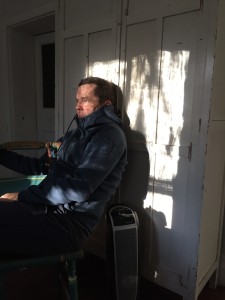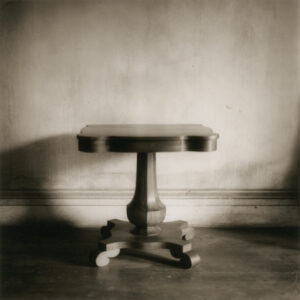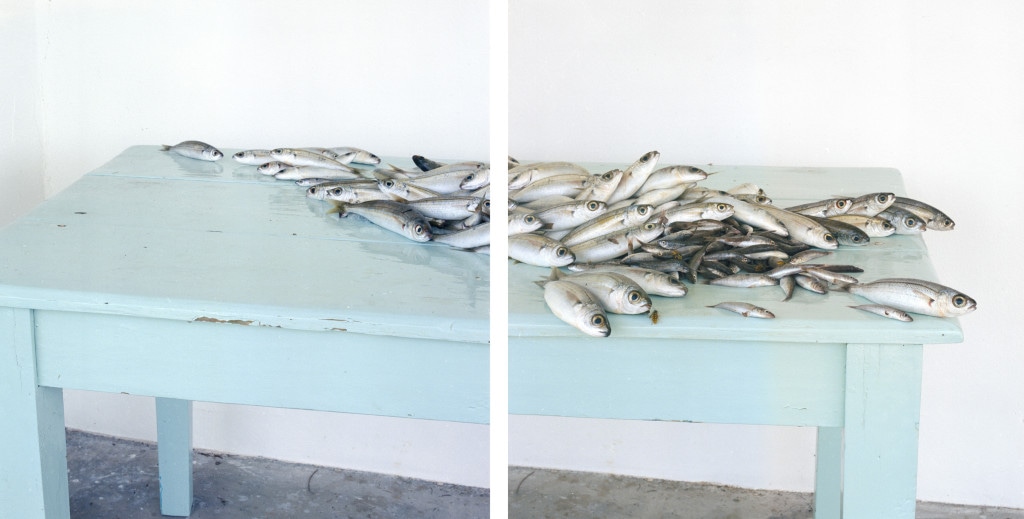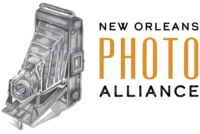Profile by Renee Allie
 I first met David Halliday back in the 90’s when I co-owned Icon’s Gallery with fellow photographer, Cecil Rimes. Being two photographers we made it a point to have photography as one of the featured shows each month so it was common to be visited by the newest photographers in town. I’ll never forget the portfolio David showed me that day, as it was absolutely unique in my experience. The prints stood out—they were really small, no more than 4” x 4”, but were beautifully printed and toned with sepia and selenium, and they were gorgeously rich—almost luminescent and they had torn edges. The subject matter was also unique, I remember marveling about them to Cecil when he returned, “what were they?” he asked, “bushes!” I said. In fact they were little botanical “portraits” of bushes, center-framed and fabulous. So David became a fixture in our gallery where we hosted 3-4 one-person shows and quite a few thematic shows that included his work as well. We also set up a deal with David to share our darkroom in exchange for prints of his work. It was, as they say, the beginning of a beautiful friendship.
I first met David Halliday back in the 90’s when I co-owned Icon’s Gallery with fellow photographer, Cecil Rimes. Being two photographers we made it a point to have photography as one of the featured shows each month so it was common to be visited by the newest photographers in town. I’ll never forget the portfolio David showed me that day, as it was absolutely unique in my experience. The prints stood out—they were really small, no more than 4” x 4”, but were beautifully printed and toned with sepia and selenium, and they were gorgeously rich—almost luminescent and they had torn edges. The subject matter was also unique, I remember marveling about them to Cecil when he returned, “what were they?” he asked, “bushes!” I said. In fact they were little botanical “portraits” of bushes, center-framed and fabulous. So David became a fixture in our gallery where we hosted 3-4 one-person shows and quite a few thematic shows that included his work as well. We also set up a deal with David to share our darkroom in exchange for prints of his work. It was, as they say, the beginning of a beautiful friendship.
When he was three, David’s parents moved with their five kids to Ridgefield Connecticut where his mother had discovered an abandoned carriage house “buried in bush” that she was able to buy and restore. They lived in the renovated carriage house for 18 years; a description of that time is one of an idyllic country childhood that included outdoor activities, a pet donkey, chickens, and a family home so filled with warmth that it was the house in which all the neighborhood kids wanted to hang out.
In his teens David began taking photography and ceramics at the Worcester School that featured a community art center with classes open to the public. His photo teacher made quite an impression on David as he had very specific, “art path” ideas about photography that included the exclusive use of Agfa Portriga Rapid—a warm tone art paper favored by many artists of the period. He was very supportive of David and very inspiring as well.
A short time later David was accepted by Syracuse University into their fine art program but somehow along the way was “seduced into” the communications department on a photojournalism tract. The change from an art focus to a commercial one was a mistake for David; he became miserable with the program and ultimately dropped out. Discouraged by school, he left photography behind and made his way to New York City and later Hudson, NY where he spent the rest of his 20’s completely immersed in cooking.
In 1991 his friend Randy was moving down to New Orleans to become a chef at Bistro at the Maison de’Ville and he suggested David go with him to help out.

David readily agreed to the new adventure as he had been to New Orleans once before on vacation and thought it was exciting and beautiful in an “imperfect way”. By this point David had taken up photography again and was developing what was to become his signature style. Living in New Orleans, soon the textures and patina of the city began to creep into his classic Northeastern painterly aesthetic giving it an enhanced, grittier tone. David’s work at this time was mostly portraits and objects—the objects being very much like portraits themselves, each piece having a distinctive feeling of gravitas as if to say “here I am, consider me: the toaster, the fan, the plant”…
New Orleans was still the “Big Easy”; part of which meant that remarkable, unique apartments were available for a song. David lived in a gorgeous, slave quarter apartment with a lush courtyard across from the Richelou Hotel in the French Quarter. His mode of transportation was an old one-speed bike. He’d left the restaurant, was working in a bakery uptown and doing a lot more photography. Leaving New Orleans for most of the summer, David started taking extended “photo” trips that involved unusual locations like Tonga and Russia. His work began to “open up” featuring giant vistas, architecture and landscapes.

After Icons closed David was picked up by Cole Pratt Gallery for a few years and then started showing at the newly opened Gallery for Southern Photography on Julia Street. His work was getting more notice and so were his sales, especially from his representation by Fay Gold in Atlanta and the Sailors’ Valentine Gallery in Nantucket. In 1998 he finally made the decision to give up all other outside work in favor of being a full-time art photographer. And, in 2000 after a particularly good year, David bought his first home in New Orleans on 4th Street and he began the arduous task of renovating a 19th century neglected property. David says he “thrives on the process” of putting a house back together, seeing it as a “big old antique”.
Post Katrina David bought the corner store next to his house and kept both for a few years, renovating and renting portions of the properties until the economy tanked and he had to sell the corner store. The Gallery for Southern Photography also folded and he started showing with Arthur Roger Gallery.
Recently David was back up in Hudson, NY and a savvy realtor asked him if he wanted to see an interesting listing near the Hudson River in Schodack Landing—a tiny village about 20 minutes from Hudson. The house was a 3,000 square foot brick farmhouse on several acres next door to an old cemetery; it dated to 1776. Of course he had to have it; and now he does.
After 20+ years in New Orleans David quite suddenly sold his beloved 4th street house and moved the entire contents of it and his studio directly to Schodack Landing—to his new house and his new renovation project. 
I asked him if he was putting in a wet darkroom in the new house and he explained that he’s already planning it. It seems that there’s a back bedroom in which the dormer window appears on the outside of the house but has been closed off on the inside, this David feels is the perfect spot to install a fan, the enlarger will fit into a closet in the room and the rest of the space will make a large, very comfortable darkroom. He says the new house is really more complete than his other house was when he bought it but he’s looking forward to completing the renovation work and getting on to some photography. He is still planning on completing a series that he had started in New Orleans on vernacular architecture and says he is “side-glancing” and taking note of many of the things around him that he plans to photograph in the future.
In musing about his time in New Orleans, David says he loved the humid, tropical environment and the atmosphere of permissiveness that gave him the opportunity to explore his creativity without “roadblocks”. He says he misses it and he will be back, definitely to visit and possibly more down the road.
